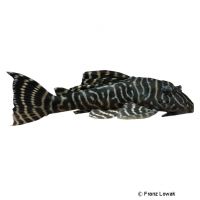Rio Curua Pleco L401 (Hypancistrus sp. 'L401')
| Rio Curua Pleco L401 Hypancistrus sp. 'L401' | |
|---|---|
| Name | Rio Curua Pleco L401 |
| Name Lat. | Hypancistrus sp. 'L401' |
| Family | Suckermouth Armoured Catfishes |
| Family lat. | Loricariidae |
| Order | Catfishes |
| Order lat. | Siluriformes |
| Origin | Brazil |
| Habitat | Streams |
| Diet | Omnivore, soft wood |
| pH | 6.0-7.5 |
| Behavior | Nocturnal, peaceful |
| Keeping | Individual, group |
| Care Level | Moderate |
| Reproduction | Cave spawner |
| Breeding | Difficult |
| Life Span | 5-8 years |
| Protection | No |
| Metric Units | |
| Size | 12-14 cm |
| Temperature | 26-30 °C |
| Hardness | 1-15 °dH |
| Aquarium | ~ 200 l |
| US Units | |
| Size | 4.7"-5.5" |
| Temperature | 79-86 °F |
| Hardness | 18-267 ppm |
| Aquarium | ~ 50 gal |
Distribution and habitat
The distribution area of the Rio Curua Loricariid L401 is the Rio Curuà in Parà, Brazil. They live in rivers and streams, preferably in sections with low current. Roots protruding into the water, sunken tree trunks and branches serve as their habitat.
Maintenance
The aquarium should have robust planting, with roots and branches that provide hiding places and are also part of their diet, as well as caves and a sandy substrate. Subdued light and a weak current is ideal.
No ammonia, ammonium and nitrite should be detectable, and the nitrate value should not exceed 100 mg/l. To ensure the water quality and oxygen content, a filter and heater adapted to the aquarium size is required, as well as lighting for the species-appropriate day-night rhythm of the animals.
Diet
They prefer animal food, except for juveniles, which feed mainly on vegetable food. For a balanced diet, feed once a day with a high-quality dry food for loricariid catfish (granules, pellets, chips, tablets), supplemented with algae leaves, soft wood and fresh vegetables, such as zucchini, broccoli, bruised peas, scalded spinach, as well as zoopankton, cyclops, daphnia, artemia, mosquito larvae, shrimp and mussel meat (live or frozen)
Only feed as much as will be eaten within a few minutes, excluding plant foods. Regular and varied feeding promotes health and increases resistance.
Behaviour and compatibility
They are crepuscular to nocturnal. Within the species and towards other loricariids they often behave territorially, therefore several animals should only be kept in larger, richly structured tanks. Towards other fish they are very peaceful and can be socialized well with them
Basically, only compatible fish species with similar demands on water quality and water temperature should be socialized.
Sex dimorphism
Males have a thickened first pectoral fin ray and more and longer odontodes (pointed skin teeth) than females.
Reproduction and breeding
The offspring has already succeeded several times. The small clutch is cared for by the male. After 12-14 days the fry swim freely and must be fed several times a day with special rearing food. In a community tank breeding is hardly possible, because the fry are easy prey.
Important
Aquarium plants are basically not used as food for them, but they can be damaged or uprooted. They have a strong sucking mouth, with spoon-shaped teeth for scraping off wood and an intestinal flora that enables the fish to digest the cellulose.
When fishing, use the finest mesh nets possible to prevent the hard rays of the pectoral fins or the skin teeth (odontodes) from getting caught on the bone plates, which can cause painful puncture wounds when touched.
The well-being of the fish should be checked regularly. Temperature should be checked daily, pH, hardness and nitrate levels at least every 14 days. Regular partial water changes are recommended, even when contaminant levels have not yet reached the upper limit. Sudden changes in water quality should be avoided. Newly introduced fish must be accustomed slowly to the water in the aquarium.
Further literature can be found in your pet store.
References
Text: Werner Winter; Image: Franz Lowak
Source: BMELV (1998): Tierschutzgutachten - Haltung von Zierfischen (Süßwasser); ENGELMANN (2005): Zootierhaltung - Tiere in menschlicher Obhut: Fische, Verlag Harri Deutsch; SCHMIDT, WERNER, LECHNER (2005): MiniAtlas L-Welse, Bede-Verlag
- Gemäß § 21 Abs. 5 Tierschutzgesetz idgF
